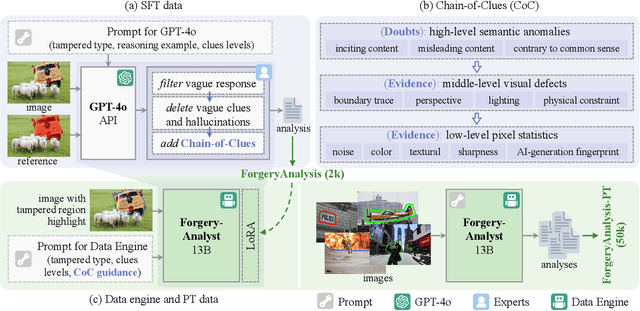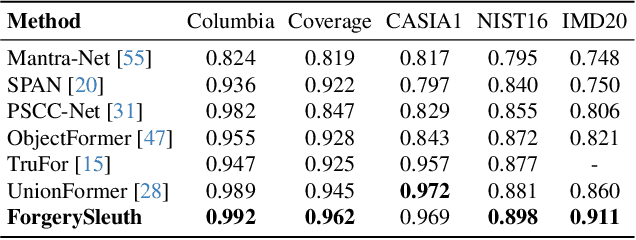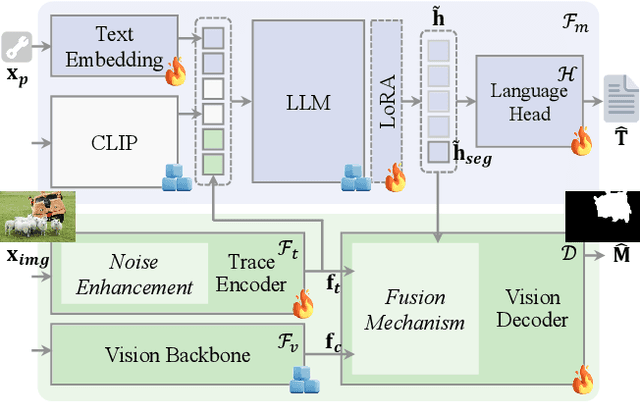Haoran Jiang
HypoChainer: A Collaborative System Combining LLMs and Knowledge Graphs for Hypothesis-Driven Scientific Discovery
Jul 23, 2025Abstract:Modern scientific discovery faces growing challenges in integrating vast and heterogeneous knowledge critical to breakthroughs in biomedicine and drug development. Traditional hypothesis-driven research, though effective, is constrained by human cognitive limits, the complexity of biological systems, and the high cost of trial-and-error experimentation. Deep learning models, especially graph neural networks (GNNs), have accelerated prediction generation, but the sheer volume of outputs makes manual selection for validation unscalable. Large language models (LLMs) offer promise in filtering and hypothesis generation, yet suffer from hallucinations and lack grounding in structured knowledge, limiting their reliability. To address these issues, we propose HypoChainer, a collaborative visualization framework that integrates human expertise, LLM-driven reasoning, and knowledge graphs (KGs) to enhance hypothesis generation and validation. HypoChainer operates in three stages: First, exploration and contextualization -- experts use retrieval-augmented LLMs (RAGs) and dimensionality reduction to navigate large-scale GNN predictions, assisted by interactive explanations. Second, hypothesis chain formation -- experts iteratively examine KG relationships around predictions and semantically linked entities, refining hypotheses with LLM and KG suggestions. Third, validation prioritization -- refined hypotheses are filtered based on KG-supported evidence to identify high-priority candidates for experimentation, with visual analytics further strengthening weak links in reasoning. We demonstrate HypoChainer's effectiveness through case studies in two domains and expert interviews, highlighting its potential to support interpretable, scalable, and knowledge-grounded scientific discovery.
Detect Anything 3D in the Wild
Apr 10, 2025Abstract:Despite the success of deep learning in close-set 3D object detection, existing approaches struggle with zero-shot generalization to novel objects and camera configurations. We introduce DetAny3D, a promptable 3D detection foundation model capable of detecting any novel object under arbitrary camera configurations using only monocular inputs. Training a foundation model for 3D detection is fundamentally constrained by the limited availability of annotated 3D data, which motivates DetAny3D to leverage the rich prior knowledge embedded in extensively pre-trained 2D foundation models to compensate for this scarcity. To effectively transfer 2D knowledge to 3D, DetAny3D incorporates two core modules: the 2D Aggregator, which aligns features from different 2D foundation models, and the 3D Interpreter with Zero-Embedding Mapping, which mitigates catastrophic forgetting in 2D-to-3D knowledge transfer. Experimental results validate the strong generalization of our DetAny3D, which not only achieves state-of-the-art performance on unseen categories and novel camera configurations, but also surpasses most competitors on in-domain data.DetAny3D sheds light on the potential of the 3D foundation model for diverse applications in real-world scenarios, e.g., rare object detection in autonomous driving, and demonstrates promise for further exploration of 3D-centric tasks in open-world settings. More visualization results can be found at DetAny3D project page.
ForgerySleuth: Empowering Multimodal Large Language Models for Image Manipulation Detection
Nov 29, 2024



Abstract:Multimodal large language models have unlocked new possibilities for various multimodal tasks. However, their potential in image manipulation detection remains unexplored. When directly applied to the IMD task, M-LLMs often produce reasoning texts that suffer from hallucinations and overthinking. To address this, in this work, we propose ForgerySleuth, which leverages M-LLMs to perform comprehensive clue fusion and generate segmentation outputs indicating specific regions that are tampered with. Moreover, we construct the ForgeryAnalysis dataset through the Chain-of-Clues prompt, which includes analysis and reasoning text to upgrade the image manipulation detection task. A data engine is also introduced to build a larger-scale dataset for the pre-training phase. Our extensive experiments demonstrate the effectiveness of ForgeryAnalysis and show that ForgerySleuth significantly outperforms existing methods in generalization, robustness, and explainability.
Task Consistent Prototype Learning for Incremental Few-shot Semantic Segmentation
Oct 16, 2024



Abstract:Incremental Few-Shot Semantic Segmentation (iFSS) tackles a task that requires a model to continually expand its segmentation capability on novel classes using only a few annotated examples. Typical incremental approaches encounter a challenge that the objective of the base training phase (fitting base classes with sufficient instances) does not align with the incremental learning phase (rapidly adapting to new classes with less forgetting). This disconnect can result in suboptimal performance in the incremental setting. This study introduces a meta-learning-based prototype approach that encourages the model to learn how to adapt quickly while preserving previous knowledge. Concretely, we mimic the incremental evaluation protocol during the base training session by sampling a sequence of pseudo-incremental tasks. Each task in the simulated sequence is trained using a meta-objective to enable rapid adaptation without forgetting. To enhance discrimination among class prototypes, we introduce prototype space redistribution learning, which dynamically updates class prototypes to establish optimal inter-prototype boundaries within the prototype space. Extensive experiments on iFSS datasets built upon PASCAL and COCO benchmarks show the advanced performance of the proposed approach, offering valuable insights for addressing iFSS challenges.
CLAY: A Controllable Large-scale Generative Model for Creating High-quality 3D Assets
May 30, 2024



Abstract:In the realm of digital creativity, our potential to craft intricate 3D worlds from imagination is often hampered by the limitations of existing digital tools, which demand extensive expertise and efforts. To narrow this disparity, we introduce CLAY, a 3D geometry and material generator designed to effortlessly transform human imagination into intricate 3D digital structures. CLAY supports classic text or image inputs as well as 3D-aware controls from diverse primitives (multi-view images, voxels, bounding boxes, point clouds, implicit representations, etc). At its core is a large-scale generative model composed of a multi-resolution Variational Autoencoder (VAE) and a minimalistic latent Diffusion Transformer (DiT), to extract rich 3D priors directly from a diverse range of 3D geometries. Specifically, it adopts neural fields to represent continuous and complete surfaces and uses a geometry generative module with pure transformer blocks in latent space. We present a progressive training scheme to train CLAY on an ultra large 3D model dataset obtained through a carefully designed processing pipeline, resulting in a 3D native geometry generator with 1.5 billion parameters. For appearance generation, CLAY sets out to produce physically-based rendering (PBR) textures by employing a multi-view material diffusion model that can generate 2K resolution textures with diffuse, roughness, and metallic modalities. We demonstrate using CLAY for a range of controllable 3D asset creations, from sketchy conceptual designs to production ready assets with intricate details. Even first time users can easily use CLAY to bring their vivid 3D imaginations to life, unleashing unlimited creativity.
MVHuman: Tailoring 2D Diffusion with Multi-view Sampling For Realistic 3D Human Generation
Dec 15, 2023Abstract:Recent months have witnessed rapid progress in 3D generation based on diffusion models. Most advances require fine-tuning existing 2D Stable Diffsuions into multi-view settings or tedious distilling operations and hence fall short of 3D human generation due to the lack of diverse 3D human datasets. We present an alternative scheme named MVHuman to generate human radiance fields from text guidance, with consistent multi-view images directly sampled from pre-trained Stable Diffsuions without any fine-tuning or distilling. Our core is a multi-view sampling strategy to tailor the denoising processes of the pre-trained network for generating consistent multi-view images. It encompasses view-consistent conditioning, replacing the original noises with ``consistency-guided noises'', optimizing latent codes, as well as utilizing cross-view attention layers. With the multi-view images through the sampling process, we adopt geometry refinement and 3D radiance field generation followed by a subsequent neural blending scheme for free-view rendering. Extensive experiments demonstrate the efficacy of our method, as well as its superiority to state-of-the-art 3D human generation methods.
HumanGen: Generating Human Radiance Fields with Explicit Priors
Dec 10, 2022



Abstract:Recent years have witnessed the tremendous progress of 3D GANs for generating view-consistent radiance fields with photo-realism. Yet, high-quality generation of human radiance fields remains challenging, partially due to the limited human-related priors adopted in existing methods. We present HumanGen, a novel 3D human generation scheme with detailed geometry and $\text{360}^{\circ}$ realistic free-view rendering. It explicitly marries the 3D human generation with various priors from the 2D generator and 3D reconstructor of humans through the design of "anchor image". We introduce a hybrid feature representation using the anchor image to bridge the latent space of HumanGen with the existing 2D generator. We then adopt a pronged design to disentangle the generation of geometry and appearance. With the aid of the anchor image, we adapt a 3D reconstructor for fine-grained details synthesis and propose a two-stage blending scheme to boost appearance generation. Extensive experiments demonstrate our effectiveness for state-of-the-art 3D human generation regarding geometry details, texture quality, and free-view performance. Notably, HumanGen can also incorporate various off-the-shelf 2D latent editing methods, seamlessly lifting them into 3D.
 Add to Chrome
Add to Chrome Add to Firefox
Add to Firefox Add to Edge
Add to Edge